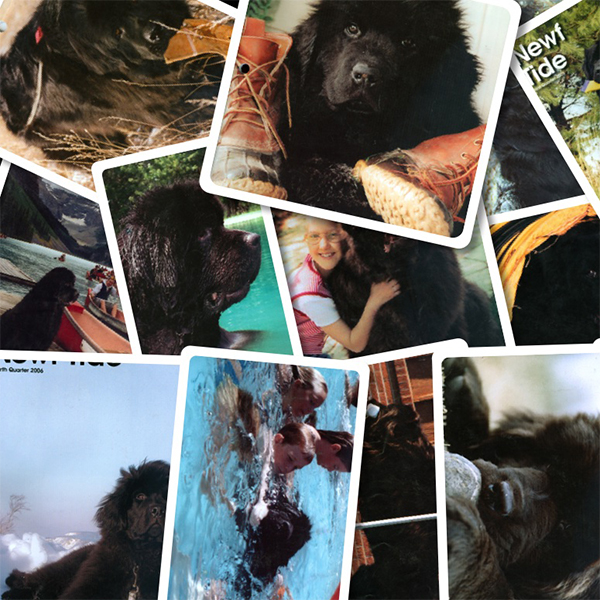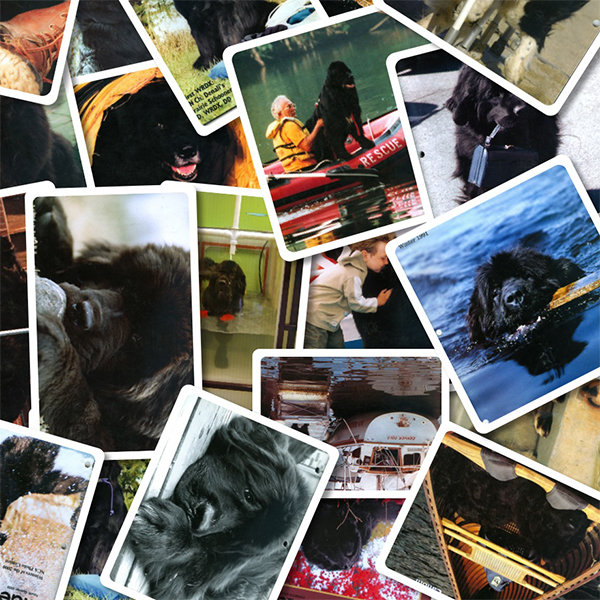by Roger Powell
|
A few days ago, Consie and I were walking with Cladina and Kaministiquia along county highway |
Our dogs have some games that do not include Consie and me: chase and tag and wrestle and race to the back fence. Many of our puppies have played soccer with their food bowls. Most outgrew the game fairly quickly, in part because they found our metal bowls impossible to flip upright when they landed up-side-down on the kitchen floor. Nokomis, however, learned quickly to hold her up-side-down bowl with a paw, catch a tooth under the edge and flip it. She played soccer with her bowl pretty much throughout her life. She would even flip bowls upright for our other dogs when they wanted to bring a bowl to Consie or me to fill. She always had a smug demeanor when she flipped a bowl for another dog, as though she were thinking that any dog of worth should surely be able to flip its own bowl. Cladina, Nokomis’s great granddaughter, can also flip bowls upright. Her favorite place to play soccer with her bowl is the frame cabin we use at the remote field station where Consie and I teach some summers. The bare, wood floors, open stud and plywood walls, and minimal furniture make the cabin a bangingly-good place to play soccer.
Nonetheless, all good dog owners also play games with their dogs. These games are important. They help us to establish our relationships with our dogs and to learn to know our dogs better. When we play with our dogs, we and our dogs must communicate to cooperate. The dogs speak dog but understand English, we speak English and understand dog, and the communication works. Some games are pretty standard, like chase and fetch. Often though, the most rewarding games are those that we and our dogs make up new. Consie and I have long played “Go find” with our girls, hiding small dog biscuits around the living room while the girls are on a Down-Stay out of site in the kitchen.
The game finishes when the dogs have found the last biscuit. At a conference years ago, I picked up a foam rubber brain about the size of my fist that was an advertising gimmick for some company that I have long forgotten. I thought the dogs might like the brain, which they did, too much. Something about the brain’s smell and texture made the dogs want to mouth and chew it incessantly. Shortly, the
brain was confined to a basket on the kitchen counter. One day, when she obviously wanted to play a game, Milakokia walked to the counter, looked at the brain, and then looked square at me to get my attention. OK, she wanted the brain, but something about her manner was new. She walked around the living room, poking her nose in hidden places, then walked back to the brain. She had just invented “Find-the-brain,” which is still a favorite game of the girls we have now. The brain is no longer fully intact but it still feels and smells as enticing as always and finding it after a long search around the living room is its own reward.
When Consie and I moved to Minnesota in winter 2010, the rural setting of our house gave me different options for running than I had had back in North Carolina. Now I could run distances that matched the abilities of each of our girls individually.
I ran with the dogs on lead to reinforce their staying close to me and to push the older girls to keep up a good pace. Mikinaak, our oldest girl who had just turned nine before we moved, ran with me the quarter mile down our driveway to Stebly Road and then the short distance to highway 88, and then home again. Mikinaak always picked up her pace when we turned around, so I took to removing her lead when we reached our driveway. As soon as the lead was off, Mikinaak galloped well ahead of me, then would drop to a trot. By our second run, it was clear that she did not want me to get ahead of her. Whenever I caught up, she galloped ahead.Our runs home along the driveway became spurts of speed for her to get ahead, then trots just a tad slower than my running speed: spurt and slower, spurt and slower. She had made a new game with me: stay ahead till we get home. Mikinaak always slowed coming up the last little hill to the garage, but that first winter, she always beat me to the steps. During winter 2011, Mikinaak began to slow and sometimes I had to encourage her to stay ahead. And then in summer, I maintained steady encouragement through our whole run. I last ran with Mikinaak only a couple days before she died in August. She still played our game, galloping more slowly now to get ahead. And she beamed when she beat me to the steps.
The next time you play a game with your newf, give her a hug from me.
reprinted from NewfTide 2011

